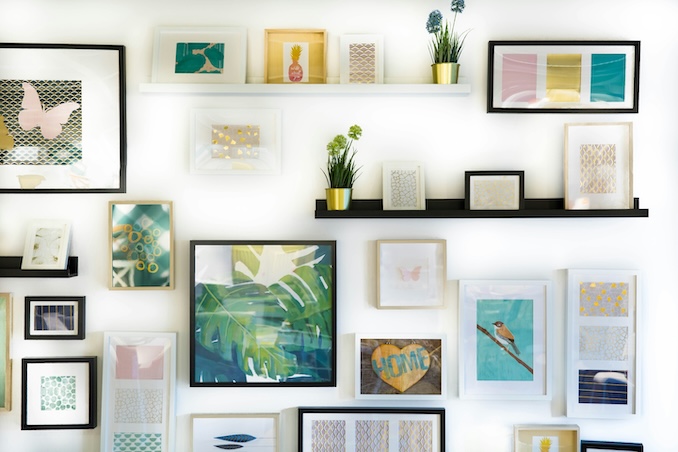Posters have long been a powerful way to express personality, style, and creativity. Yet not every poster has to look the same—there are countless opportunities to make them stand out. From artistic design techniques to personalized touches, posters can evolve from simple wall décor into meaningful, eye-catching statements. If you’re considering giving your walls more character, choosing canvas prints as a medium offers both durability and a premium look while still allowing the creative freedom posters are known for. Below, we explore the top five methods to ensure your posters are truly one of a kind.

How to Create Unique Canvas Prints
Experiment with Bold Typography
Typography isn’t just about choosing a font; it’s about setting the tone and mood of the entire poster. The right typeface can communicate emotion, purpose, and identity at first glance. Oversized, bold fonts paired with minimal backdrops can transform a simple word or phrase into a powerful visual statement. Consider how different font styles, such as serif for elegance, sans-serif for modern simplicity, or handwritten styles for personal warmth, affect the impression of the poster. Beyond just the type of font, experimenting with spacing, alignment, and layering can dramatically enhance the design. For example, overlapping large letters with imagery or playing with transparency can create a striking fusion of text and visual art.
Posters that use bold typography don’t just convey a message; they demand attention, becoming focal points that draw viewers in from across the room. By treating typography as both text and art, your poster can achieve a balance of readability and aesthetic appeal that sets it apart.
Use Limited Color Palettes
Color plays a crucial role in poster design, influencing mood, readability, and the overall impact on viewers. While it’s tempting to use many colours, limiting the palette to just two or three creates a stronger and more harmonious effect. A poster with a carefully chosen palette feels intentional and polished, guiding the viewer’s eye to what matters most. For example, a black-and-white design with a single red accent can immediately capture attention and convey drama, while pastel shades combined with a bold accent bring softness and freshness. Limited palettes also ensure that posters remain versatile, fitting seamlessly into different environments, whether hung in modern offices, creative studios, or personal living spaces.
Moreover, restricting colours makes it easier to maintain brand consistency if the poster is for professional use. By focusing on contrast and complementary shades, you allow the design to breathe, preventing clutter and ensuring the final poster feels both stylish and impactful.
Incorporate Abstract or Minimalist Art
Abstract and minimalist art are two design approaches that can make posters stand out while keeping them timeless. Abstract art allows you to break free from strict forms and realism, transforming simple shapes, lines, and brush strokes into visually engaging patterns. These designs often evoke curiosity, inviting viewers to interpret their own meaning, which makes the poster more interactive and memorable. Minimalist design, on the other hand, is rooted in the principle of “less is more.” By using clean lines, structured layouts, and intentional negative space, minimalist posters achieve elegance without overwhelming the eye. Both approaches ensure that the design remains versatile, fitting seamlessly into modern interiors, creative studios, or professional settings. What makes these styles particularly effective is their ability to balance aesthetic appeal with emotional resonance—abstract designs spark imagination, while minimalism creates calm and clarity.
When creating posters with abstract or minimalist influence, consider the following ideas:
- Geometric shapes. Circles, triangles, and lines arranged in unusual ways can form striking abstract compositions.
- Brush stroke effects. Layered paint textures or digital brush designs bring energy and depth to posters.
- Monochrome minimalism. A single shade paired with bold negative space adds elegance and focus.
- Line art illustrations. Simple outlines of objects or figures keep the design clean yet expressive.
- Texture overlays. Subtle grain, paper folds, or canvas textures provide character without clutter.
- Asymmetry. Breaking away from perfectly centred layouts creates modern, eye-catching tension.
By embracing abstract or minimalist principles, you can design posters that go beyond decoration. They become thought-provoking pieces of visual art that elevate any space and spark conversations.
Personalise with Photography
Photography adds intimacy and meaning to posters, particularly when images are personal. Travel photos, family portraits, or artistic snapshots can be reimagined into statement posters with creative cropping, color adjustments, or overlays. Choosing canvas as the base material enhances the photo’s texture and depth, turning ordinary shots into museum-like wall art. Below is a quick comparison to illustrate the effect of photography-based posters:
|
Poster Style |
Visual Impact |
Best Use Case |
|
Travel Photography |
Evokes memories and adventure |
Living rooms, offices |
|
Family Portraits |
Adds warmth and personality |
Bedrooms, family spaces |
|
Artistic Photography |
Enhances sophistication and uniqueness |
Galleries, creative work settings |
Add Layers with Mixed Media
Posters no longer need to remain simple, flat prints with a single layer of imagery. By incorporating mixed media, you can introduce depth, texture, and storytelling into the design. Techniques such as combining digital collages with scanned hand-drawn sketches, overlaying photographs with painted elements, or adding subtle texture scans like fabric or paper folds can make posters feel tactile and multidimensional. This layered approach transforms posters from static visuals into engaging works of art that spark curiosity and invite viewers to take a closer look.
Mixed media is also a fantastic way to reflect individuality, since no two creations will ever be exactly alike. For instance, you might merge personal photographs with vintage illustrations, or pair bold digital graphics with delicate pencil sketches. This process adds character and ensures your poster carries a unique artistic fingerprint. Beyond aesthetics, mixed media also enhances storytelling—by blending different techniques and materials, you can communicate mood, narrative, or emotion in a way that flat, single-style posters cannot. The result is a poster that not only decorates a space but also tells a story, making it both personal and memorable.
Posters as a Canvas for Creativity
Posters should never be underestimated as mere decorative items—they are versatile storytelling tools that bridge the gap between art and personal expression. With techniques such as bold typography, limited palettes, abstract or minimalist design, photography, and mixed media, posters can be transformed into visual statements that resonate with viewers on a deeper level. Every design choice—whether it’s the simplicity of minimalist lines or the complexity of layered textures—contributes to how a poster communicates meaning and atmosphere.
When thoughtfully designed, posters become much more than wall fillers. They can inspire, comfort, energize, or challenge the people who see them. Whether created for a personal room, an office space, or a public display, unique posters showcase creativity in its purest form. They are timeless, versatile, and endlessly adaptable to your vision. By exploring different techniques and embracing experimentation, you ensure that your posters are not just seen but remembered.
FAQ
What makes a poster unique?
A poster becomes unique when it reflects individuality through creative choices such as typography, colour schemes, or personalized imagery. It’s less about trends and more about how well the design represents your message or personality.
Why choose canvas for posters?
Canvas enhances the depth, richness, and durability of posters. The textured surface creates a gallery-like appearance, making posters look more refined and professional compared to standard prints.
Can I design posters without professional tools?
Yes. Many online platforms and design apps allow you to create posters using templates, fonts, and stock images. However, adding personal photos or custom graphics is the best way to ensure originality.
Are minimalist posters effective?
Absolutely. Minimalist posters use simplicity to focus attention on essential elements. They can be powerful in conveying messages without distractions and often match modern interiors.
How do posters differ when printed on canvas?
When printed on canvas, posters gain a tactile quality. Colors appear softer yet richer, and the texture adds character, transforming posters into long-lasting art pieces.
What sizes are best for posters?
The best size depends on where the poster will be displayed. Smaller sizes are perfect for intimate spaces like bedrooms, while larger posters make bold statements in living rooms or offices.
Can posters combine photography and illustration?
Mixing photography with illustrations creates striking, mixed-media posters. This approach combines realism with artistic flair, creating posters that are both personal and visually captivating.

